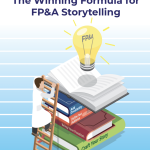On February 8, 2024, the Amsterdam FP&A Board gathered for the 13th session at Spaces Amstel in Amsterdam, delving into the art of FP&A Storytelling. The event drew representatives from a wide array of industries, including Royal Schiphol Group, ABN Amro Bank, Shell, Maersk, L’Oréal, Nike, Coca-Cola, and many others. With thirty-five participants, discussions revolved around sharing experiences and refining storytelling techniques to effectively communicate financial insights and strategies across different contexts. This gathering showcased the dedication of industry leaders to improving FP&A practices and fostering innovation in the financial landscape.
The event was sponsored by Pigment in partnership with IWG.
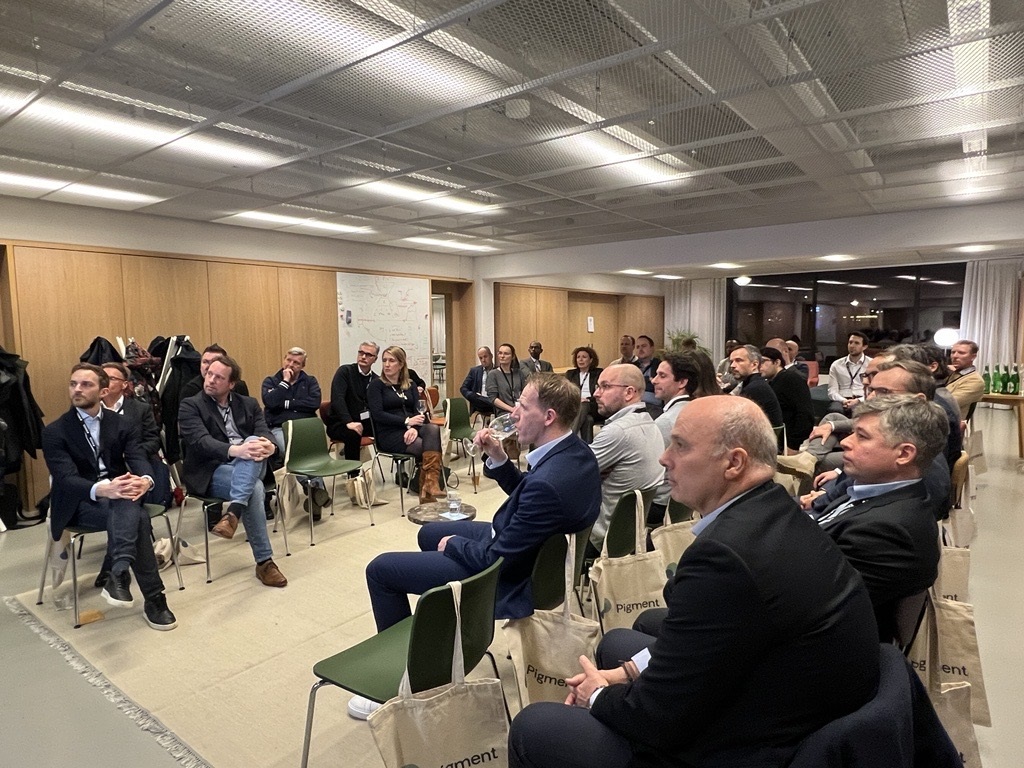
Figure 1: Amsterdam FP&A Board №13, February 2024
Key Takeaways from the Session
Our profession continuously evolves. Over the years, we've made significant progress in understanding business data and translating it into valuable insights. Everything began with the need to analyse business data for control purposes; then, it evolved into providing insights through Business Partnering. But now, we've entered a new phase: storytelling with insights that drive real impact. It's about harnessing data to create a compelling narrative that motivates action among stakeholders. Storytelling with data may become a skill differentiator for FP&A professionals in the near future.
What Challenges Do We Face?
Despite the increasing importance of understanding data and making decisive actions, the amount of time FP&A teams spend on these tasks hasn't changed significantly since 2019. Interestingly, the 2023 FP&A Trends Survey shows that many FP&A teams are still so focused on data collection and validation instead of driving actions and providing insights. While there has been some improvement, progress has been slow over the past three years.

Figure 2
Why Is FP&A Storytelling Important?
“FP&A Storytelling turns financial and non-financial data into a powerful story that builds trust, aligns teams, and drives decisions in business.”
At the beginning of the session, participants were prompted to consider what elements contribute to the effectiveness of a story. Here are the key points that came up most frequently:
Accurate data and visualisation
The attendees emphasised the need to ensure clarity in data definitions and utilise visuals that directly support the narrative. It was noted that relying solely on raw data may not effectively convey the story, and there was a warning against using too many visuals as they can distract from the message.
Knowing your audience
Customising the narrative to fit the audience and situation was a common theme. The participants stressed the significance of adjusting the story as needed and actively interacting with stakeholders to understand their unique challenges.
Actionable messaging
Clarity in conveying the purpose of the story was also highlighted. There were differing opinions on whether to introduce the insights at the beginning or end, depending on stakeholders' preferences.
Simple, consistent and focused messages
Amsterdam FP&A Board members emphasised the need to ensure that the message aligns with the broader context and flows seamlessly with preceding narratives.
Following this discussion, the group explored three fundamental pillars for creating a compelling FP&A story. These building blocks are summarised in the picture below: data, visuals and narrative.
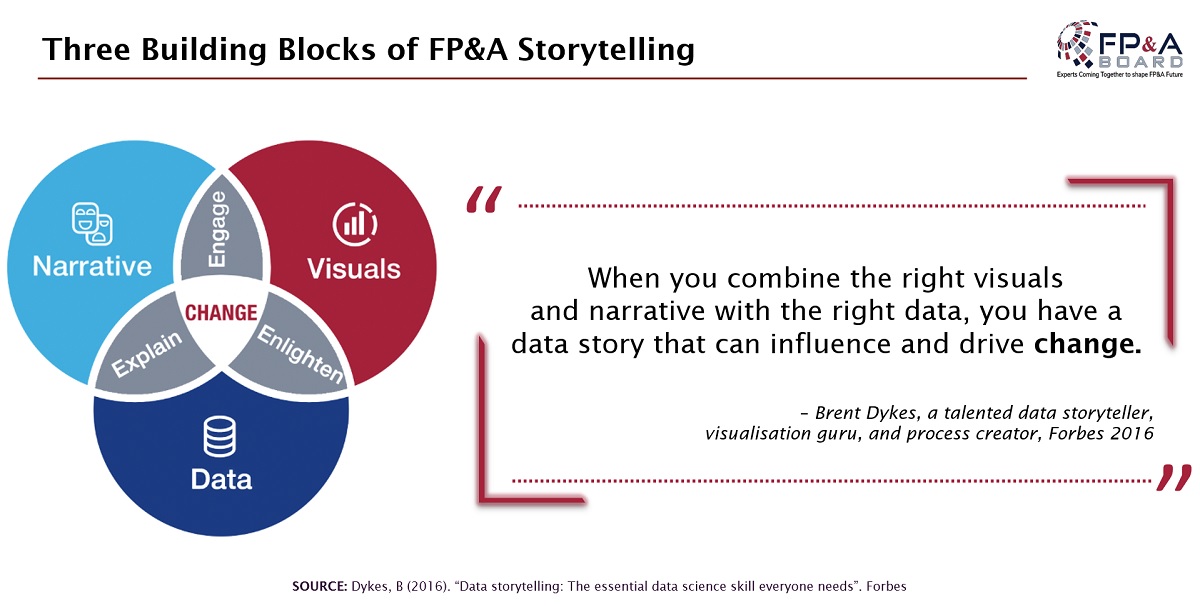
Figure 3
1. Narrative: How to build an effective narrative?
When crafting a narrative, it's crucial to consider the following points highlighted by the forum:
- Audience understanding: Consider the concerns and priorities of your audience. Engage with colleagues regularly and listen to their stories.
- Clarity of expectations: Clearly communicate what you expect from your audience, matching their expertise level and aligning with their interests and objectives.
- Conciseness: Less is more. Avoid overwhelming slides with excessive information and limit the use of slides. Use relatable examples and meaningful data.
- Effective visuals: Use colours only to emphasise important points and incorporate visuals only when they enhance the narrative.
- Ensure your narrative has a clear beginning, main part, and end.
Additionally, the discussion touched upon three essential dimensions of a narrative:
- Ethos or ethical appeal: Establish credibility by demonstrating expertise, transparency, and consistency.
- Logos or rational appeal: Present a well-structured argument supported by reliable data, clear insights, visuals, and logical reasoning.
- Pathos or emotional appeal: Evoke emotions such as empathy, sympathy, or excitement and connect with shared values and beliefs to foster a deeper connection.
The discussion facilitator, Larysa Melnychuk, also introduced the winning formula for FP&A Storytelling, which resonated well within the group:
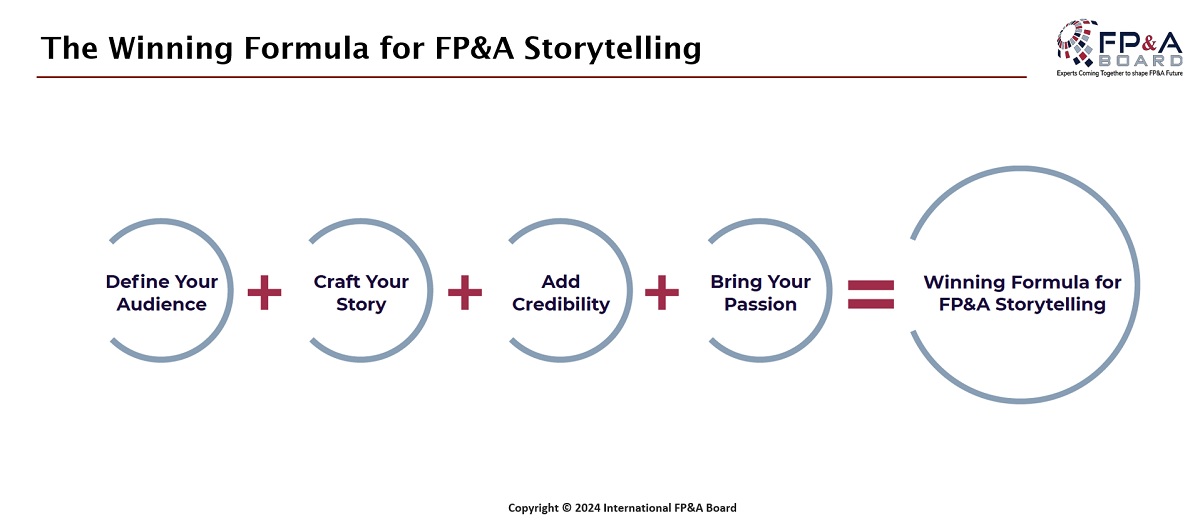
Figure 4
2. Visuals
When using visuals, it is always important to ensure that they convey an actionable message. According to the FP&A Trends Data Visualisation Maturity Matrix, the more advanced a company becomes, the faster it can generate tailored reports and insights for the entire business and individual stakeholders.
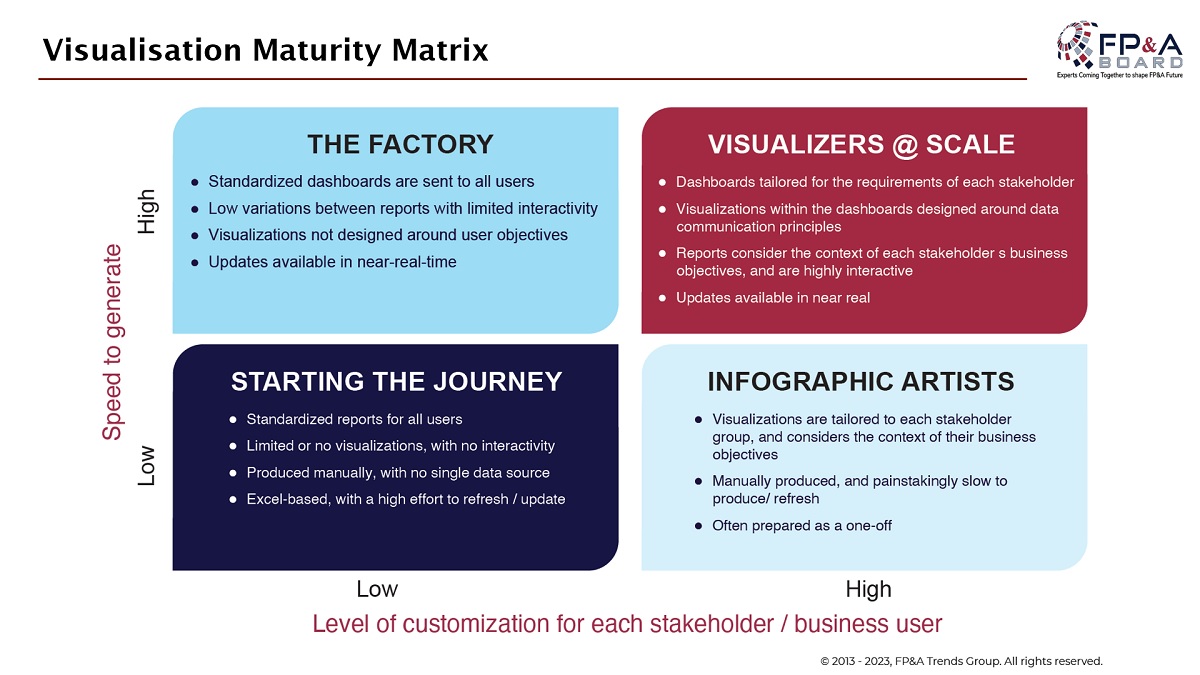
Figure 5
3. Data
The attendees also highlighted the need to select the most impactful data to drive our narrative and visualisation. Except for it, the Amsterdam FP&A Board members also explored the 6 technology trends shaping FP&A Storytelling, outlined below:
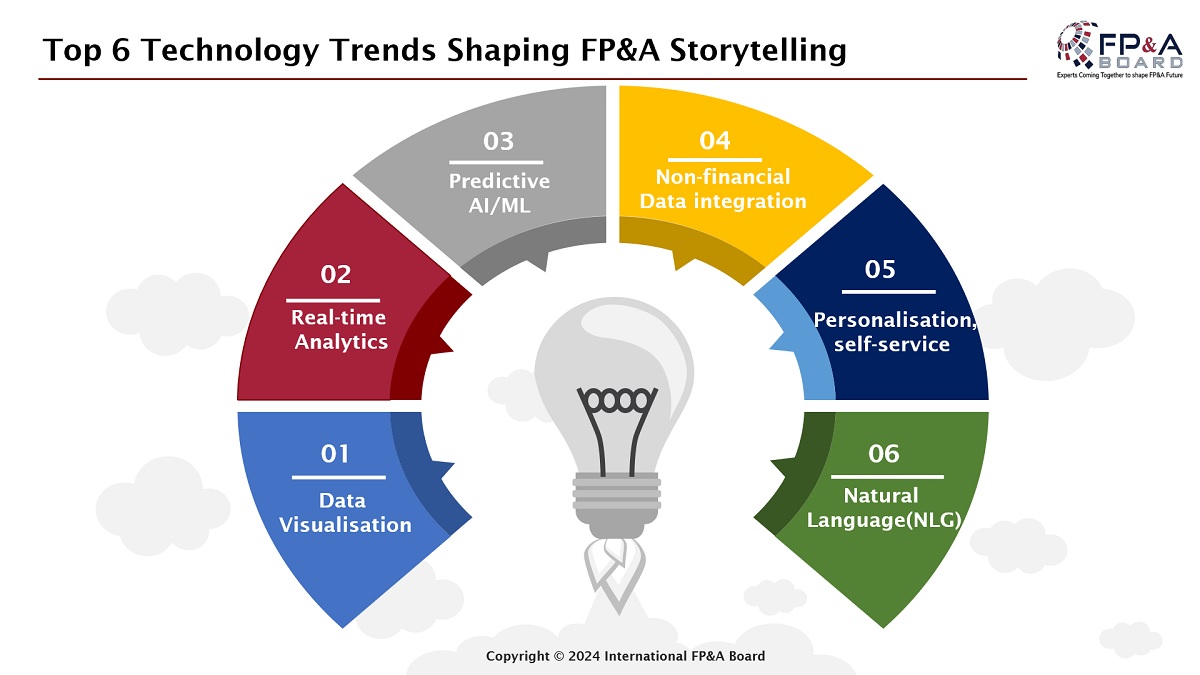
Figure 6
Insights from Group Work
During the final part of the evening, the participants were divided into three groups to engage in deeper discussions on specific topics:
- Group 1 - Narrative: How can we create a clear, engaging narrative tailored to our audience?
- Group 2 - Visuals: How can we design impactful, comprehensible visuals for our story?
- Group 3 - Data: How can we effectively identify and analyse relevant data for our narrative?
The most relevant reflections from the groups are outlined below:
- Know your audience: Regularly meet with stakeholders and understand their priorities.
- Ensure that the narrative aligns with the shared business context.
- Let data inform your narrative, but don't let it dictate it entirely. Make it data-informed instead of data-driven.
- Use colours when necessary to emphasise points and choose them wisely to avoid distractions.
- Use visuals to enhance the message, but avoid overloading.
- Use accurate and reliable data for your analysis.
- Ensure consistency by having one definition for each mentioned Key Performance Indicator (KPI).

Figure 7: Group Work, Amsterdam FP&A Board №13, February 2024
Conclusions and Recommendations
After two hours of constructive engagement, the evening was concluded with these 7 steps for effective FP&A Storytelling.
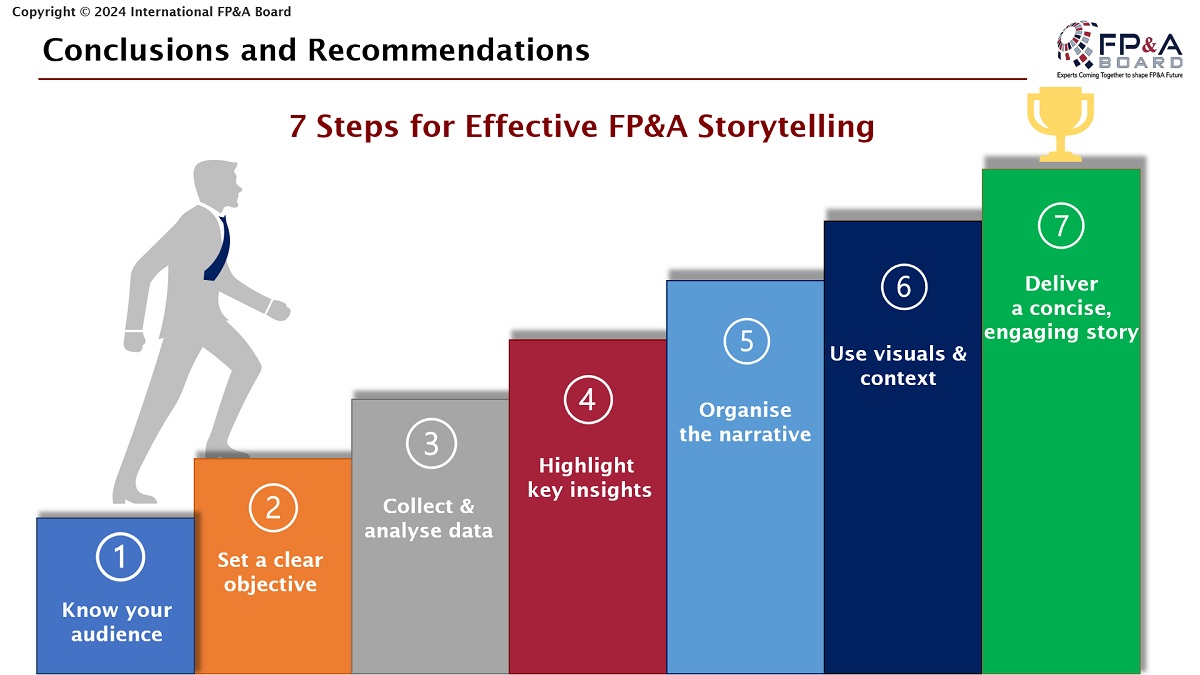
Figure 8
Following the formal part of the event, the participants had the opportunity to network further and engage in discussions over drinks.



